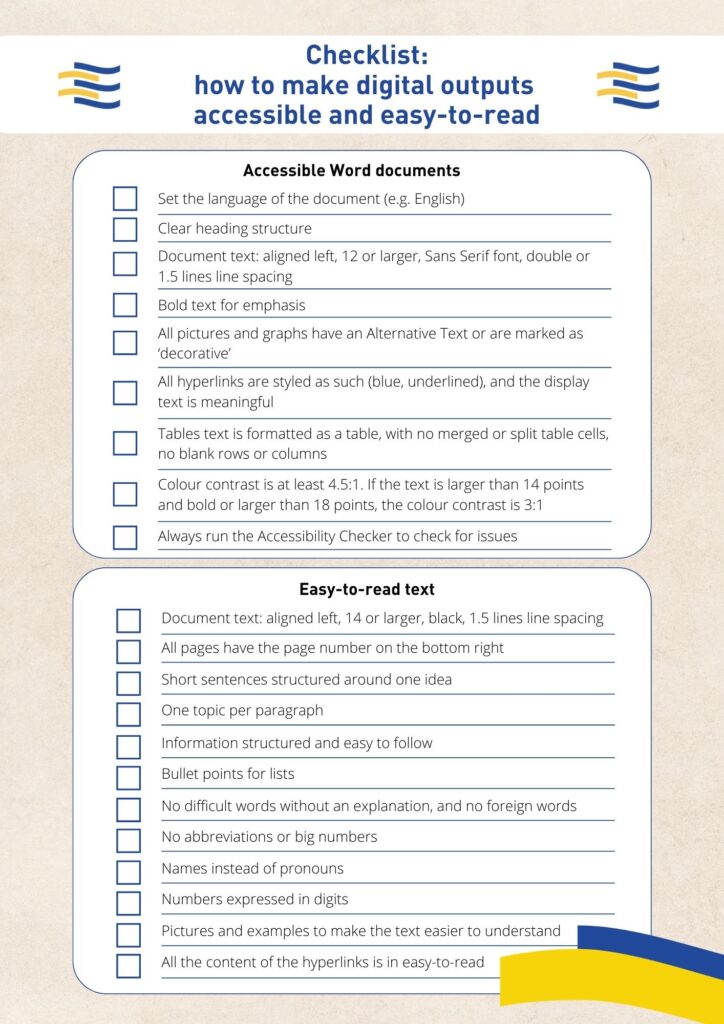Inclusive design in communication – Improving the accessibility of Equality Bodies’ outputs

Flat vector illustration of a group containing inclusive and diversified people all together without any difference.
Focused on building participants’ capacity on accessibility and easy-to-read, this training took place online on 17 and 19 January, with valuable input from the European Disability Forum and Inclusion Europe.
Find below the learning materials, the training report and a checklist available for download.
Background
Equality Bodies are public organisations who assist victims of discrimination, monitor and report on discrimination issues, and contribute to an awareness of rights and a societal valuing of equality. In order to effectively carry out these duties, they need to provide information that is available to as many people as possible. For this reason, Equality Bodies’ outputs should be designed with an inclusive approach, be accessible and easy to ready so that everyone can access and easily process information.
Objectives
This training was addressed to members of Equinet’s Communication Working Group and other staff of Equality Bodies or National Human Rights Institutions working on producing accessible materials, so that they understand:
- how to make their digital materials accessible, for instance by adding Alt text and by carrying out accessibility checks;
- how to create easy-to-read materials
Agenda
The webinar was made up of two sessions.
Session I: How to make digital materials accessible
17 January 2022 10:00 – 12:30 CET, online
Roberta Lulli and Loredana Dicsi from the European Disability Forum (EDF) gave practical tips and examples on how to make digital material accessible, focusing on making Word documents and Powerpoint presentations accessible to screen readers.
During the discussions, participants were able to ask very concrete questions on how to tackle technical challenges they face in creating accessible documents, as well as how to apply accessiblity to social media and websites. EDF have toolkits available on all of these issues, which are available in the learning materials below.
- Presentation: How to make digital materials accessible by Lorendana Dicsi and Roberta Lulli, European Disability Forum
Session II: How to create easy to read materials
19 January 2022 10:00 – 12:30 CET, online
Soufiane El Amrani from Inclusion Europe presented the main rules to keep in mind when creating easy to read materials. Soufiane explained why it is important for Equality Bodies to make information available in easy to read format, and gave examples of how Inclusion Europe creates easy to read versions of legal texts. See the guidelines produced by Inclusion Europe on all of these topics in the learning materials below.
Christine Mifsud, Lorraine Pleven and Isabel Bonello from the Commission for the Rights of Persons with Disabilities in Malta described how they create easy to read materials in their organisation.
Both presentations underlined the importance of having a person with intellectual disabilities on the team or working with an NGO who does, to make sure that all material can be well understood by everyone.
- Presentation: Easy-to-Read by Soufiane El Amrani, Inclusion Europe
Learning materials
Accessibility
- Web accessibility: W3C Accessibility standards overview
- EDF Toolkit: Accessible Word Documents
- EDF Toolkit: Accessible PowerPoint presentation
- EDF Toolkit: Accessible social media
- EDF Toolkit: Accessible online event
- EDF Toolkit: Accessible video
Easy to read
- European standards for making information easy to read
- Checklist of main rules for easy to read
- How to use the easy to read logo
- Inclusion Europe’s explanation of difficult words (EN, DE, FR, ES, PO)
- Illustrations for easy to read material:
Training report
This report summarises the learnings of the training and includes examples of good practices from four Equality Bodies on developing accessible websites and creating easy-to-read text.
Checklist: How to make digital outputs accessible and easy-to-read
Here’s a short checklist on how to make digital outputs accessible and easy-to-read. It is included in the report and below in PDF and in an accessible Word version. Download the checklist and/or print it, and it will guide you when producing inclusive communication materials!
Checklist: How to make digital outputs accessible and easy-to-read (PDF)
Checklist: How to make digital outputs accessible and easy-to-read (Accessible Word version)

